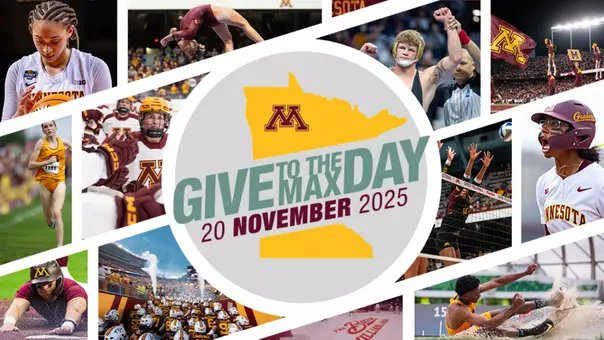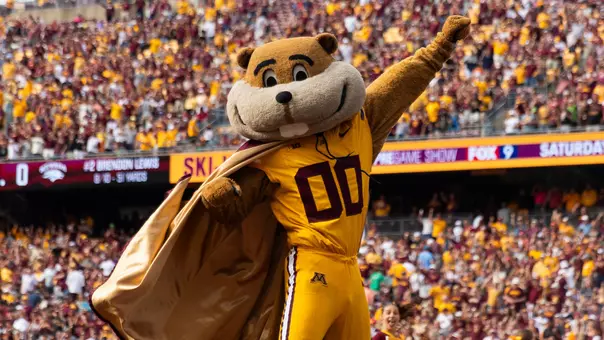University of Minnesota Athletics
Gopher Athletics and HopeKids: A Growing Partnership
9/28/2010 12:00:00 AM | Athletics
Gopher Athletics and HopeKids: A Growing Partnership
By Charlie Armitz
Athletic Communications Student Assistant
If you told any Gopher fan that more than 80 percent of University of Minnesota student-athletes did community service, they would probably think the service was mandatory.
It isn’t. And perhaps no one is more thankful for the fact than Josh Taylor of the HopeKids organization.
HopeKids is a nonprofit, charitable organization that provides ongoing events and activities for children with cancer and other life-threatening medical conditions. Started in Phoenix, Ariz. in 2001, the organization has since added chapters in Minnesota (Nov. 2006) and Utah (Sept. 2008).
“Our program has exploded,” says Taylor, the executive director of HopeKids in the Twin Cities. “We’re serving close to 700 families in the Twin Cities chapter, which reaches families throughout the entire midwest.”
A key element in HopeKids’ recent growth is its affiliation with the University of Minnesota, specifically its work with student-athletes, who volunteer at HopeKids events regularly throughout the year. HopeKids hosts about 90 large events a year, including the HopeDay Festival, which included over 500 University of Minnesota volunteer student-athletes on Sept. 12. HopeKids also provides the families more than 150 different ticket opportunities a year.
Central to the HopeKids mission is the belief that hope instills a positive attitude in kids that improves their chances of recovery.
“Our whole concept is that hope is a powerful medicine,” Taylor says. “We believe that the anticipation of the event is as important as the event itself. If we can give the kids something to keep them looking forward to the future with hope and joy and anticipation, then their willingness to keep fighting is going to increase. If we provide an ongoing program of events, then there’s a constant state of anticipation.”
Perhaps a state of relief, too, especially for children whose condition often alienates them from the rest of society.
“[At the events], the kids see that they’re not the only kids that are sick,” says Taylor. "They're not the only ones that are bald, or have a mask, or have a breathing tube or an oxygen mask. . . . Everyone is normal. No one gets stared at."
Well, maybe the student-athletes do. But, as Taylor explains, it’s that kind of idealization that makes student-athletes such great volunteers.
“The kids look up to [the athletes] as superstars,” Taylor says, citing the involvement of prominent Gophers such as Adam Weber and Eric Decker. “It has such an appeal to the kids to be playing and interacting with the athletes at our events. And [the athletes] are so high energy. They’re young and they’re fit, and they’ve got a lot of energy to give these kids.
“I also think there’s a flipside to it, where it’s a pretty somber reminder to the athletes that they’re so blessed to be so fit and so healthy, and able to . . . play sports. [There are] a lot of kids who don’t have that ability. It’s a reminder that not everyone is as fortunate as them.”
Certainly, the athletes deserve credit. But to recognize just the athletes would overlook the hard work and dedication of the University staff—an effort headed by Anissa Lightner, the University’s assistant director of student-athlete welfare.
Lightner, now in her ninth year at the University, coordinates all of the outreach efforts for the University’s athletic department, including HopeKids events. She takes volunteer requests from organizations all over the state, and then recruits her athletes to volunteer by sending them weekly emails with information on the upcoming week’s events. Then, on event days, she often times provides transportation service for the athletes that signed up, while also spending time with many of the HopeKids families.
Lightner’s work has brought outreach efforts at the U of M to a whole new level. Under her leadership and an improved online database system, 614 student-athletes participated in at least one outreach event over the past year, totaling more than 8,500 hours of service, or eight and a half hours per student-athlete. That’s 8,500 hours of pure heart—hours that go unpaid, and in no way are forced upon the student-athletes.
“We’ve set a culture of giving back,” Lightner explains. “We don’t volunteer because we have to, we volunteer because it’s the right thing to do.”
“The athletes are always so happy [at events],” adds Taylor. “The kids love having them there.”
Indeed, virtuosity is a tradition at the U of M—and nowhere is that more evident than at the annual HopeDay Festival, a massive University-hosted carnival that brought in more than 400 volunteer student-athletes in 2009. The festival, which Lightner likens to a miniature State Fair, gives HopeKids children a chance to join their favorite athletes in a variety of activities—face painting, kickball, rock climbing, a petting zoo, and much more. The 2010 festival, which ran from 12 to 4 p.m. on Sunday, September 12, also offered a shuttle on the M.A.G.I.C. bus to TCF Bank Stadium, where the children met with Gophers football players for a couple of hours.
The festival has gotten “bigger and better” each year, says Lightner, an improvement indicative of the direction that U of M-HopeKids relations is headed in the near future. Despite the troubled economy, Lightner is confident that the program will continue to grow, especially in its marketing and public relations efforts. “I will do whatever I can to [overcome difficulties] and [build] a program to greatness,” she says.
But to both Lightner and Taylor, the HopeKids mission remains the same. As does the simple-yet-brilliant concept that hope, just like treatment, can be a powerful medicine.
“Our program is very simple,” Taylor says. “Our mission is very simple. And our program is very powerful.”
By Charlie Armitz
Athletic Communications Student Assistant
If you told any Gopher fan that more than 80 percent of University of Minnesota student-athletes did community service, they would probably think the service was mandatory.
It isn’t. And perhaps no one is more thankful for the fact than Josh Taylor of the HopeKids organization.
HopeKids is a nonprofit, charitable organization that provides ongoing events and activities for children with cancer and other life-threatening medical conditions. Started in Phoenix, Ariz. in 2001, the organization has since added chapters in Minnesota (Nov. 2006) and Utah (Sept. 2008).
“Our program has exploded,” says Taylor, the executive director of HopeKids in the Twin Cities. “We’re serving close to 700 families in the Twin Cities chapter, which reaches families throughout the entire midwest.”
A key element in HopeKids’ recent growth is its affiliation with the University of Minnesota, specifically its work with student-athletes, who volunteer at HopeKids events regularly throughout the year. HopeKids hosts about 90 large events a year, including the HopeDay Festival, which included over 500 University of Minnesota volunteer student-athletes on Sept. 12. HopeKids also provides the families more than 150 different ticket opportunities a year.
Central to the HopeKids mission is the belief that hope instills a positive attitude in kids that improves their chances of recovery.
“Our whole concept is that hope is a powerful medicine,” Taylor says. “We believe that the anticipation of the event is as important as the event itself. If we can give the kids something to keep them looking forward to the future with hope and joy and anticipation, then their willingness to keep fighting is going to increase. If we provide an ongoing program of events, then there’s a constant state of anticipation.”
Perhaps a state of relief, too, especially for children whose condition often alienates them from the rest of society.
“[At the events], the kids see that they’re not the only kids that are sick,” says Taylor. "They're not the only ones that are bald, or have a mask, or have a breathing tube or an oxygen mask. . . . Everyone is normal. No one gets stared at."
Well, maybe the student-athletes do. But, as Taylor explains, it’s that kind of idealization that makes student-athletes such great volunteers.
“The kids look up to [the athletes] as superstars,” Taylor says, citing the involvement of prominent Gophers such as Adam Weber and Eric Decker. “It has such an appeal to the kids to be playing and interacting with the athletes at our events. And [the athletes] are so high energy. They’re young and they’re fit, and they’ve got a lot of energy to give these kids.
“I also think there’s a flipside to it, where it’s a pretty somber reminder to the athletes that they’re so blessed to be so fit and so healthy, and able to . . . play sports. [There are] a lot of kids who don’t have that ability. It’s a reminder that not everyone is as fortunate as them.”
Certainly, the athletes deserve credit. But to recognize just the athletes would overlook the hard work and dedication of the University staff—an effort headed by Anissa Lightner, the University’s assistant director of student-athlete welfare.
Lightner, now in her ninth year at the University, coordinates all of the outreach efforts for the University’s athletic department, including HopeKids events. She takes volunteer requests from organizations all over the state, and then recruits her athletes to volunteer by sending them weekly emails with information on the upcoming week’s events. Then, on event days, she often times provides transportation service for the athletes that signed up, while also spending time with many of the HopeKids families.
Lightner’s work has brought outreach efforts at the U of M to a whole new level. Under her leadership and an improved online database system, 614 student-athletes participated in at least one outreach event over the past year, totaling more than 8,500 hours of service, or eight and a half hours per student-athlete. That’s 8,500 hours of pure heart—hours that go unpaid, and in no way are forced upon the student-athletes.
“We’ve set a culture of giving back,” Lightner explains. “We don’t volunteer because we have to, we volunteer because it’s the right thing to do.”
“The athletes are always so happy [at events],” adds Taylor. “The kids love having them there.”
Indeed, virtuosity is a tradition at the U of M—and nowhere is that more evident than at the annual HopeDay Festival, a massive University-hosted carnival that brought in more than 400 volunteer student-athletes in 2009. The festival, which Lightner likens to a miniature State Fair, gives HopeKids children a chance to join their favorite athletes in a variety of activities—face painting, kickball, rock climbing, a petting zoo, and much more. The 2010 festival, which ran from 12 to 4 p.m. on Sunday, September 12, also offered a shuttle on the M.A.G.I.C. bus to TCF Bank Stadium, where the children met with Gophers football players for a couple of hours.
The festival has gotten “bigger and better” each year, says Lightner, an improvement indicative of the direction that U of M-HopeKids relations is headed in the near future. Despite the troubled economy, Lightner is confident that the program will continue to grow, especially in its marketing and public relations efforts. “I will do whatever I can to [overcome difficulties] and [build] a program to greatness,” she says.
But to both Lightner and Taylor, the HopeKids mission remains the same. As does the simple-yet-brilliant concept that hope, just like treatment, can be a powerful medicine.
“Our program is very simple,” Taylor says. “Our mission is very simple. And our program is very powerful.”
Cub Plays of the Week
Wednesday, September 24
Cub Plays of the Week
Thursday, September 18
Cub Plays of the Year
Monday, July 14
2024-25 Gopher Sports Year in Review
Wednesday, July 09




